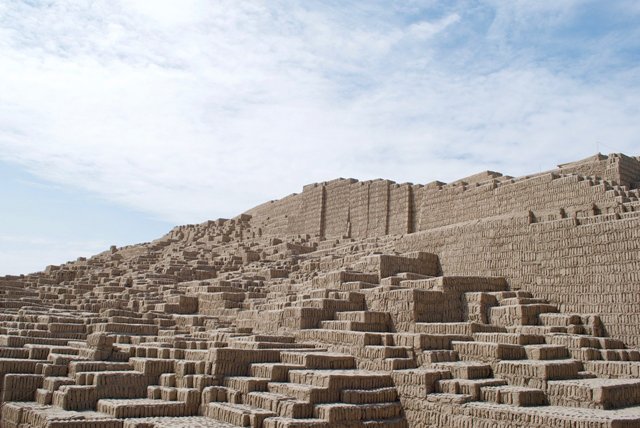When Christopher Columbus's flagship, the Santa Maria, ran aground on Haitian reefs in 1492, the crew used its timbers to construct Fort Navidad, the island's earliest European structure. It was later destroyed by Arawak Indians.

Huaca Pucllana, possibly from the Quechua Wak'a, is a local sanctuary to a protective deity, a sacred place in a pyramid built by members of the Lima culture, a pre-Inca indigenous coastal civilization that lasted in the region from about 100 CE to 650 CE.
Lima's culture and its contemporaries were notable for their mastery of irrigation, which allowed them to develop settlements in a considerable territory where a desert climate predominated.
HuacaPucllana partially served as an administrative site for the surrounding irrigation area. The complex is separated by a large wall that extends from north to south, and spaces that were probably used for public meetings, storage, and other production-focused businesses are centered along its east side.
The western half was a ceremonial sector, which contained the 22-meter high pyramid and was used for religious rites.
The culture of Lima was surpassed by the Wari culture at some point around 700 CE. Under the Wari, HuacaPucllana was important mainly as a burial place for the nobility.
The first intact grave from this period was found in the grounds in 2008 and it contained the remains of three people: two adults wearing masks and a sacrificed child.
Today, the HuacaPucllana complex includes an area for workshops, a small souvenir shop and a restaurant overlooking the ruins. The museum displays ceramics, textiles, tools, artifacts and other remains found at the site over the years.
These vestiges belonging between the years 400 and 1400 of the pre-Inca cultures Lima, Wari and Ychsma, were abandoned and not valued for a long time until 1967 when this mythical site was recovered.
In 1984 HuacaPucllana was officially inaugurated and in 1987 it was declared an intangible archaeological zone by the Peruvian state. One of the visits we recommend to make during your trip to Lima.
The guided tours begin by exploring the lower parts of the pyramid where you can see vessels and vestiges of ancient squares of the ancient inhabitants of Lima.
Somewhere along the way, a model shows, beyond the limits of the current archaeological site, a representation of spaces and the way in which the Lima culture worked.
Part of the tour shows us the typical flora and fauna of the pre-Hispanic era, where you can see the friendly llamas.
The main attraction is the truncated pyramid with 7 levels, which was built with rectangular mud bricks and dried in the sun. At the top of the pyramid, it is interesting to see the contrast of the ruins with the modern buildings and houses in the streets surrounding the archaeological site.

When Christopher Columbus's flagship, the Santa Maria, ran aground on Haitian reefs in 1492, the crew used its timbers to construct Fort Navidad, the island's earliest European structure. It was later destroyed by Arawak Indians.